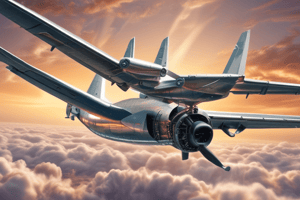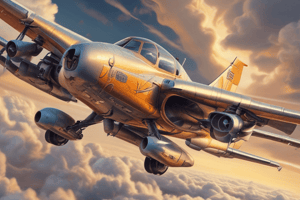Podcast
Questions and Answers
What is a critical measure of an engine's economic performance?
What is a critical measure of an engine's economic performance?
- Power output
- Engine speed
- Specific Fuel Consumption (SFC) (correct)
- Thrust-to-weight ratio
At which altitude can turbine engines experience reduced performance?
At which altitude can turbine engines experience reduced performance?
- Low altitudes
- Sea level
- High altitudes (correct)
- Cruise altitudes
What is a key factor in determining the efficiency of a propeller?
What is a key factor in determining the efficiency of a propeller?
- Engine power output
- Air density
- Blade shape and pitch (correct)
- Turbine engine design
What is a benefit of engines designed with modular components?
What is a benefit of engines designed with modular components?
How does temperature affect engine thrust?
How does temperature affect engine thrust?
What is the primary impact of a high-performance turbine engine on an aircraft?
What is the primary impact of a high-performance turbine engine on an aircraft?
What is the relationship between turbine engine design and aircraft performance?
What is the relationship between turbine engine design and aircraft performance?
What is a key factor in determining an aircraft's range?
What is a key factor in determining an aircraft's range?
What is the primary benefit of a fuel-efficient engine?
What is the primary benefit of a fuel-efficient engine?
Why is understanding turbine engine design and performance vital for pilots and aviation professionals?
Why is understanding turbine engine design and performance vital for pilots and aviation professionals?
A higher Specific Fuel Consumption value indicates a more fuel-efficient engine.
A higher Specific Fuel Consumption value indicates a more fuel-efficient engine.
Turbine engines are designed to operate inefficiently at higher altitudes.
Turbine engines are designed to operate inefficiently at higher altitudes.
The speed at which a propeller rotates does not affect its efficiency.
The speed at which a propeller rotates does not affect its efficiency.
Engines with modular components require more maintenance than those without.
Engines with modular components require more maintenance than those without.
Temperature has no impact on air density and engine thrust.
Temperature has no impact on air density and engine thrust.
The power output of an engine has no effect on the efficiency of a propeller.
The power output of an engine has no effect on the efficiency of a propeller.
An aircraft with a high-performance turbine engine will generally have a lower cruising speed.
An aircraft with a high-performance turbine engine will generally have a lower cruising speed.
Propellers have no significant role in aircraft performance.
Propellers have no significant role in aircraft performance.
A turbine engine's design has no impact on an aircraft's payload capacity.
A turbine engine's design has no impact on an aircraft's payload capacity.
Understanding turbine engine design and performance is only relevant to aircraft mechanics.
Understanding turbine engine design and performance is only relevant to aircraft mechanics.
What is the implication of a lower Specific Fuel Consumption (SFC) value for an aircraft's operational costs and environmental impact?
What is the implication of a lower Specific Fuel Consumption (SFC) value for an aircraft's operational costs and environmental impact?
How do altitude and temperature affect the performance of turbine engines, and what design considerations are necessary to mitigate these effects?
How do altitude and temperature affect the performance of turbine engines, and what design considerations are necessary to mitigate these effects?
What are the key advantages of modular design in turbine engines, and how does this impact maintenance and overall performance?
What are the key advantages of modular design in turbine engines, and how does this impact maintenance and overall performance?
How does the interaction between the propeller and engine power output affect aircraft performance, and what are the key factors influencing propeller efficiency?
How does the interaction between the propeller and engine power output affect aircraft performance, and what are the key factors influencing propeller efficiency?
What are the key implications of a high-performance turbine engine on an aircraft's overall capabilities, including speed, range, and payload capacity?
What are the key implications of a high-performance turbine engine on an aircraft's overall capabilities, including speed, range, and payload capacity?
What are the primary reasons why understanding turbine engine design and performance is essential for pilots and aviation professionals?
What are the primary reasons why understanding turbine engine design and performance is essential for pilots and aviation professionals?
How does the design of turbine engines impact an aircraft's altitude capability, and what are the implications of this for aircraft operation?
How does the design of turbine engines impact an aircraft's altitude capability, and what are the implications of this for aircraft operation?
What are the key benefits of fuel-efficient engines, and how do these impact an aircraft's operational costs and environmental impact?
What are the key benefits of fuel-efficient engines, and how do these impact an aircraft's operational costs and environmental impact?
How does the power output of a turbine engine affect the efficiency of a propeller, and what are the implications of this for prop-driven aircraft?
How does the power output of a turbine engine affect the efficiency of a propeller, and what are the implications of this for prop-driven aircraft?
What are the key implications of turbine engine design on an aircraft's overall performance, including speed, range, and payload capacity?
What are the key implications of turbine engine design on an aircraft's overall performance, including speed, range, and payload capacity?
Flashcards are hidden until you start studying
Study Notes
Aircraft Performance Systems
- Engine performance is the foundation of safe and efficient flight operations.
- It is primarily gauged by thrust in jet engines and horsepower in propeller-driven engines.
Engine Performance Fundamentals
- Turbine engine designs are marvels of modern engineering, defining aircraft capabilities.
- Characteristics of turbine engines include:
- Rapid acceleration
- High-altitude performance
- Efficiency at high speeds
- Turbine engines have intricate air intake designs, compressor stages, combustion chambers, and turbine stages, contributing to overall engine performance.
Measuring and Improving Engine Performance
- Factors influencing engine performance:
- Air density
- Temperature
- Altitude
- Engine pressure ratio (EPR) gauges and exhaust gas temperature (EGT) gauges monitor engine health and performance efficiency.
- EPR measures the pressure difference across the engine, indicating thrust output.
- EGT provides critical information on engine thermal health.
Importance of Engine Performance
- Well-maintained engines exhibit consistent, reliable performance.
- Safety is interlinked with performance, ensuring predictable engine behavior in diverse operational scenarios.
- Understanding engine performance characteristics is critical for pilots and aviation technicians.
Turbine Engine Designs
- Turbine engines are known for their high power-to-weight ratio and reliability.
- Design revolves around generating thrust by expelling hot gases at high speeds through a nozzle.
- Key factors characterizing turbine engine performance:
- Thrust-to-weight ratio
- Specific fuel consumption (SFC)
- Operational altitude and temperature
- Maintenance requirements
Engine Performance and Aircraft Capabilities
- The choice of engine impacts an aircraft's speed, range, altitude capability, and payload capacity.
- Propellers play a significant role in aircraft performance, interacting with engine power output to affect aircraft performance.
Engine Performance Fundamentals
- Engine performance is the foundation of safety and efficiency in flight operations
- Engine performance is gauged by thrust in jet engines and horsepower in propeller-driven engines
- Thrust and horsepower are benchmarks used to compare and evaluate engine designs
Turbine Engine Designs
- Turbine engines are characterized by rapid acceleration, high-altitude performance, and efficiency at high speeds
- They feature intricate air intake designs, compressor stages, combustion chambers, and turbine stages
- Turbine engines are used in airline and military applications due to their high performance at altitude and high speeds
Propeller Performance
- Propellers are the interface between horsepower and thrust
- Controlling propeller pitch is akin to shifting gears in a vehicle, allowing pilots to adapt to different flying conditions
- Propeller efficiency is determined by factors such as blade shape, pitch, and rotation speed
Measuring and Improving Engine Performance
- Engine performance is influenced by air density, temperature, and altitude
- Aircraft are equipped with engine pressure ratio (EPR) gauges and exhaust gas temperature (EGT) gauges to monitor engine health and performance efficiency
- Regular maintenance and inspections are crucial for maintaining optimal engine performance
Engine Performance and Safety
- Engine performance is critical for safety in flight operations, as it ensures pilots can depend on their aircraft to respond predictably in diverse operational scenarios
- Understanding engine performance characteristics is essential for responding to changes in engine performance during flight
Reciprocating Engines
- Reciprocating engines are used in smaller, general aviation aircraft due to their simplicity and reliability
- They have a power curve that favors lower altitudes and are suitable for bush planes and aerobatic craft
- Reciprocating engines excel in cost and maintenance simplicity
Comparison of Engine Types
- Turbine engines are more powerful and efficient at high altitudes and speeds, but also more complex and expensive to maintain
- Reciprocating engines are more suitable for general aviation due to their simplicity and cost-effectiveness
- Turbine engines are typically used in commercial and military aircraft due to their high performance and reliability
Aircraft Performance Systems
- Engine performance is the foundation of safe and efficient flight operations.
- It is primarily gauged by thrust in jet engines and horsepower in propeller-driven engines.
Engine Performance Fundamentals
- Turbine engine designs are marvels of modern engineering, defining aircraft capabilities.
- Characteristics of turbine engines include:
- Rapid acceleration
- High-altitude performance
- Efficiency at high speeds
- Turbine engines have intricate air intake designs, compressor stages, combustion chambers, and turbine stages, contributing to overall engine performance.
Measuring and Improving Engine Performance
- Factors influencing engine performance:
- Air density
- Temperature
- Altitude
- Engine pressure ratio (EPR) gauges and exhaust gas temperature (EGT) gauges monitor engine health and performance efficiency.
- EPR measures the pressure difference across the engine, indicating thrust output.
- EGT provides critical information on engine thermal health.
Importance of Engine Performance
- Well-maintained engines exhibit consistent, reliable performance.
- Safety is interlinked with performance, ensuring predictable engine behavior in diverse operational scenarios.
- Understanding engine performance characteristics is critical for pilots and aviation technicians.
Turbine Engine Designs
- Turbine engines are known for their high power-to-weight ratio and reliability.
- Design revolves around generating thrust by expelling hot gases at high speeds through a nozzle.
- Key factors characterizing turbine engine performance:
- Thrust-to-weight ratio
- Specific fuel consumption (SFC)
- Operational altitude and temperature
- Maintenance requirements
Engine Performance and Aircraft Capabilities
- The choice of engine impacts an aircraft's speed, range, altitude capability, and payload capacity.
- Propellers play a significant role in aircraft performance, interacting with engine power output to affect aircraft performance.
Studying That Suits You
Use AI to generate personalized quizzes and flashcards to suit your learning preferences.




